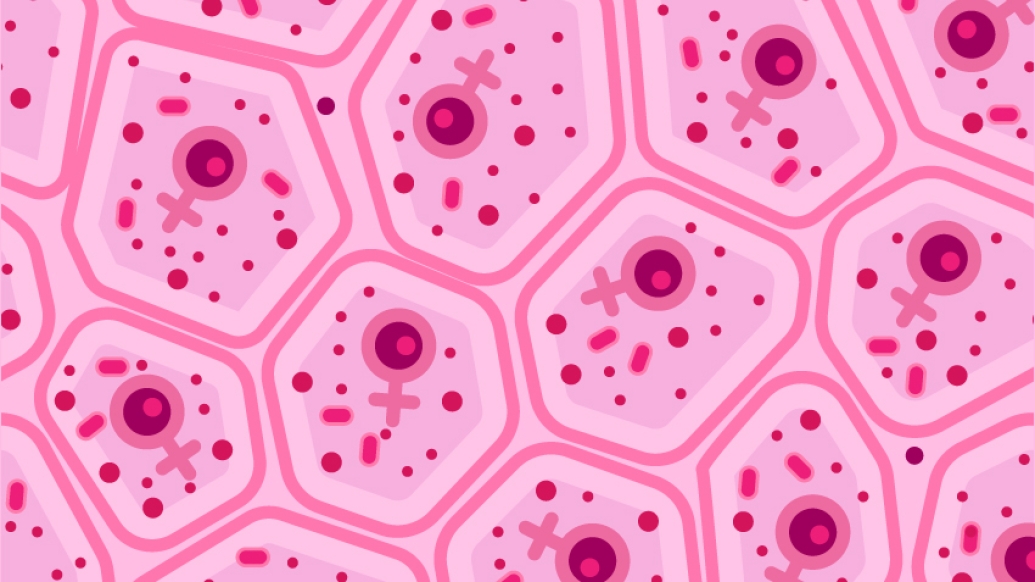Researchers cause a lupus-like disease in mice by amplifying the amount of a single “master regulator” factor — suggesting both a root cause for known differences between the sexes and a target for new treatments.
7:00 AM
Author |

It's one of the great mysteries of medicine, and one that affects the lives of millions of people: Why do women's immune systems gang up on them far more than men's do, causing far more women to develop autoimmune diseases such as lupus?
Part of the answer, it turns out, may lie in the skin.
LISTEN UP: Add the new Michigan Medicine News Break to your Alexa-enabled device, or subscribe to our daily audio updates on iTunes, Google Play and Stitcher.
New evidence points to a key role for a molecular switch called VGLL3. Three years ago, a team of University of Michigan researchers showed that women have more VGLL3 in their skin cells than men do.
Now, working in mice, they've discovered that having too much VGLL3 in skin cells pushes the immune system into overdrive, leading to a "self-attacking" autoimmune response. Surprisingly, this response extends beyond the skin, attacking internal organs, too.
SEE ALSO: 'Master Regulator' in Genes May Make Women More Susceptible to Autoimmune Diseases
Writing in JCI Insight, the team describes how VGLL3 appears to set off a series of events in skin that trigger the immune system to come running — even when there's nothing to defend against.
"VGLL3 appears to regulate immune response genes that have been implicated as important to autoimmune diseases that are more common in women but that don't appear to be regulated by sex hormones," says Johann Gudjonsson, M.D., Ph.D., who led the research team and is an associate professor of dermatology at the U-M Medical School.
"Now, we have shown that overexpression of VGLL3 in the skin of transgenic mice is by itself sufficient to drive a phenotype that has striking similarities to systemic lupus erythematosus, including skin rash and kidney injury," he says.
MORE FROM MICHIGAN: Sign up for our weekly newsletter
Gudjonsson worked with co-first authors Allison Billi, M.D., Ph.D., and Mehrnaz Gharaee-Kermani, Ph.D., and colleagues from several U-M departments to trace VGLL3's effects.
They found that extra VGLL3 in skin cells changed expression levels of a number of genes important to the immune system. Expression of many of the same genes is altered in autoimmune diseases like lupus.
Wreaking havoc
The gene expression changes caused by excess VGLL3 wreaked havoc in the mice. Their skin became scaly and raw. Immune cells thrived, filling the skin and lymph nodes. The mice also produced antibodies against their own tissues, including the same antibodies that can destroy the kidneys of lupus patients.
The researchers don't yet know what causes female skin cells to have more VGLL3 to begin with. It may be that over evolutionary time, females have developed stronger immune systems to fight off infections — but at the cost of increased risk for autoimmune disease if the body mistakes itself for an invader.
The researchers also don't know what triggers might set off extra VGLL3 activity. But they do know that in men with lupus, the same VGLL3 pathway seen in women with lupus is activated.
Many of the current therapies for lupus, which affects 1.5 million Americans, come with unwanted side effects from steroids, including increased infection risk and cancer.
Potentially safer therapies
Finding the key factors downstream of VGLL3 may identify targets for new, and potentially safer, therapies that could benefit patients of both sexes.
J. Michelle Kahlenberg, M.D., Ph.D., an associate professor in U-M's Division of Rheumatology and a senior co-author on the VGLL3 work, is recruiting patients with lupus for a study sponsored by U-M's A. Alfred Taubman Medical Research Institute that could provide answers to these questions and more.
Billi, a resident in dermatology, notes that when she speaks with patients who come to Michigan Medicine's dermatology clinics for treatment of the skin problems lupus can cause, she has to acknowledge the limits of current treatment.
Even so, she says, patients are eager to take part in studies by contributing skin and DNA samples that could lead to new discoveries about their condition.
"Many patients are frustrated that they've had to try multiple therapies and still nothing is working well," Billi says. "To be able to tell them that we're working on a mouse that has the same disease as them, and that we need their help, brings out their motivation and interest in research.
"They know that it's a long game, and they're in for it."
The research was funded by the National Institutes of Health and the University of Michigan, with additional support from the Rheumatology Research Foundation, the Dermatology Foundation, the Arthritis National Research Foundation and the National Psoriasis Foundation.
Gudjonsson and Kahlenberg are supported by and are Emerging Scholars of the Taubman Institute. U-M has applied for a patent on the VGLL3 mouse model.
Reference: JCI Insight, 2019;4(8):e127291. https://doi.org/10.1172/jci.insight.127291

Explore a variety of healthcare news & stories by visiting the Health Lab home page for more articles.

Department of Communication at Michigan Medicine
Want top health & research news weekly? Sign up for Health Lab’s newsletters today!





